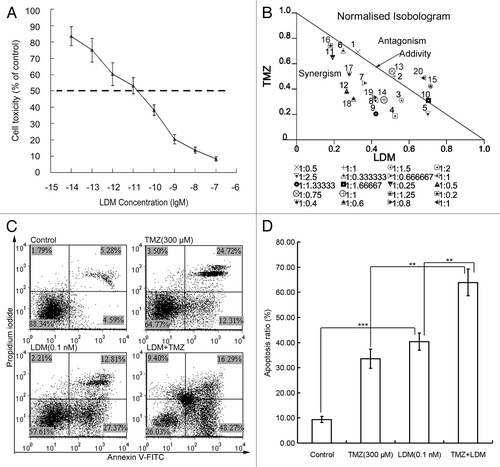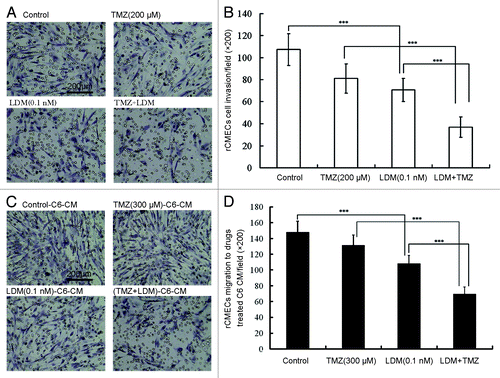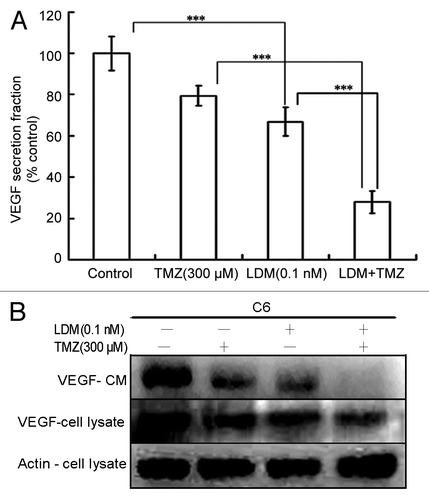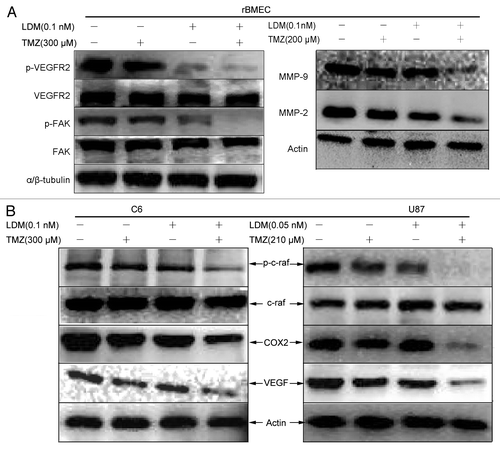Figures & data
Figure 1. The cytotoxicity and cell apoptosis of rBMECs treated with various dosing regimens were determined. (A) MTT assay showed the potently inhibitory effects of LDM on rBMECs proliferation. The dash line showed the IC50 value. (B) The normalized isobologram analysis showed synergistic interactions of LDM (10−10 to 10−14 M) with TMZ (60 μM, 90 μM, 120 μM, and 150 μM) on rBMECs cell proliferation. A large number of combinations below the additivity line indicated the synergism of LDM and TMZ. (C) The apoptosis assay was performed with Annexin V-FITC/PI double staining, the representative images of the rBMECs apoptosis treated with indicated dosing regimens were shown. The apoptosis ratio was calculated and plotted. Combinations of the two drugs exerted enhanced apoptosis ratios to rBMEC cells (D). **P < 0.01, and ***P < 0.001 between the indicated groups.

Table 1. Evaluation of synergistic effects on events associated with angiogenesis in vitro and in vivo.
Figure 2. Lidamycin acted in synergism with TMZ on rBMECs invasion and rBMECs migration induced by drugs-treated C6 cell condition medium. The invasive rBMECs were photographed (A) and enumerated (B), ***P < 0.001 between the indicated groups; the migrated rBMECs induced by drug-treated C6 cell condition medium were photographed (C) and enumerated (D), ***P < 0.001 between the indicated groups. In all the photos, the scale bar = 200 μm.

Figure 3. Combination of Lidamycin with TMZ synergistically inhibit VEGF secretion of C6 cells. The VEGF concentrations were measured with ELISA assay, and the data were plotted (A). Meanwhile, the VEGF expressions of C6 glioma cells and the conditioned medium were detected by western blot (B). ***P < 0.001 between the indicated groups.

Figure 4. Lidamycin plus TMZ exhibited synergistic anti-angiogenesis effects in vitro. (A) The tube formation inhibitions of different treatments were photographed (200×), then the intact tubes were enumerated and plotted, and the scale bar = 200 μm (B). The aortic rings were treated and photographed [(C) 40×], then the endothelial cell spreading were analyzed and plotted, and the scale bar = 40 μm (D). **P < 0.01, and ***P < 0.001, between the indicated groups.
![Figure 4. Lidamycin plus TMZ exhibited synergistic anti-angiogenesis effects in vitro. (A) The tube formation inhibitions of different treatments were photographed (200×), then the intact tubes were enumerated and plotted, and the scale bar = 200 μm (B). The aortic rings were treated and photographed [(C) 40×], then the endothelial cell spreading were analyzed and plotted, and the scale bar = 40 μm (D). **P < 0.01, and ***P < 0.001, between the indicated groups.](/cms/asset/99b44bc8-a66d-422b-9b82-d507ea98afb5/kcbt_a_10927626_f0004.gif)
Figure 5. The synergistic regulations of angiogenesis pathway by combination of LDM with TMZ. The enhanced anti-angiogenic effect of LDM combined with TMZ is associated with VEGF signal cascades. (A):For rBMEC treated with indicated regimens, the regulations of p-VEGFR2, VEGFR2, p-FAK, FAK, and MMPs were determined by western blot with corresponding primary antibodies; the results indicated that combination more efficiently inhibit angiogenic and invasive/migratory factors expression than single treatments. (B) The inhibitory effects of LDM and its synergism with TMZ on angiogenic factors secreted by C6 cells and U87 cells were determined, in which the c-raf, COX2, and VEGF were immunoblotted. Combination treatment inhibited the expressions of VEGF and COX2 more significant than single drugs; meanwhile, the activity of c-raf was downregulated sharply.

Figure 6. Synergistic enhancement of anti-angiogenesis effect of lidamycin with TMZ in subcutaneous U87 tumor sections. The microvessle density (MVD) was determined by CD31 immunofluorostain assay, and the images were photographed [(A), 200×] and enumerated (B). Red, CD31-positive blood vessels stained with Cy3-labeled secondary antibody; blue, the cell nuclei counter-stained with 4,6-diamidino-2-phenylindole (DAPI). The VEGF secretion related to angiogenesis were detected by VEGF immunofluorostain in glioma section [(C), 200×). Red, VEGF-positive areas stained with Cy3-labled secondary antibody; blue, the cell nuclei counter-stained with 4,6-diamidino-2-phenylindole (DAPI). The photos were enumerated and plotted (D). Each column represented the mean ± s.d. ***P < 0.001 between indicated groups. In all the photos, the scale bar = 200 μm.
![Figure 6. Synergistic enhancement of anti-angiogenesis effect of lidamycin with TMZ in subcutaneous U87 tumor sections. The microvessle density (MVD) was determined by CD31 immunofluorostain assay, and the images were photographed [(A), 200×] and enumerated (B). Red, CD31-positive blood vessels stained with Cy3-labeled secondary antibody; blue, the cell nuclei counter-stained with 4,6-diamidino-2-phenylindole (DAPI). The VEGF secretion related to angiogenesis were detected by VEGF immunofluorostain in glioma section [(C), 200×). Red, VEGF-positive areas stained with Cy3-labled secondary antibody; blue, the cell nuclei counter-stained with 4,6-diamidino-2-phenylindole (DAPI). The photos were enumerated and plotted (D). Each column represented the mean ± s.d. ***P < 0.001 between indicated groups. In all the photos, the scale bar = 200 μm.](/cms/asset/696877da-a195-4ec8-8c92-68dd8221fc90/kcbt_a_10927626_f0006.gif)
